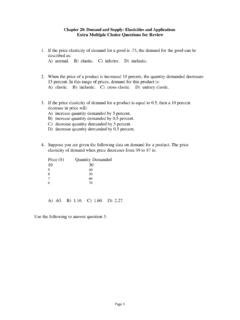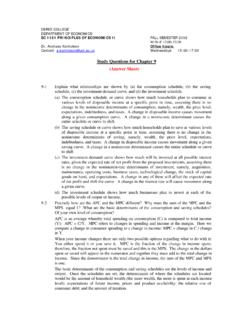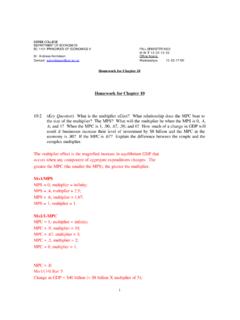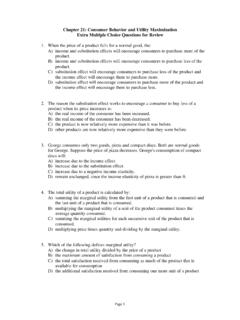Transcription of ANSWERS TO END-OF-CHAPTER QUESTIONS
1 Chapter 23- Pure Competition 276 ANSWERS TO END-OF-CHAPTER QUESTIONS 23-1 Briefly indicate the basic characteristics of pure competition, pure monopoly, monopolistic competition, and oligopoly. Under which of these market classifications does each of the following most accurately fit? (a) a supermarket in your home town; (b) the steel industry; (c) a Kansas wheat farm; (d) the commercial bank in which you or your family has an account; (e) the automobile industry. In each case justify your classification. Pure competition: very large number of firms; standardized products; no control over price: price takers; no obstacles to entry; no nonprice competition. Pure monopoly: one firm; unique product: with no close substitutes; much control over price: price maker; entry is blocked; mostly public relations advertising.
2 Monopolistic competition: many firms; differentiated products; some control over price in a narrow range; relatively easy entry; much nonprice competition: advertising, trademarks, brand names. Oligopoly: few firms; standardized or differentiated products; control over price circumscribed by mutual interdependence: much collusion; many obstacles to entry; much nonprice competition, particularly product differentiation. (a) Hometown supermarket: oligopoly. Supermarkets are few in number in any one area; their size makes new entry very difficult; there is much nonprice competition. However, there is much price competition as they compete for market share, and there seems to be no collusion. In this regard, the supermarket acts more like a monopolistic competitor.
3 Note that this answer may vary by area. Some areas could be characterized by monopolistic competition while isolated small towns may have a monopoly situation. (b) Steel industry: oligopoly within the domestic production market. Firms are few in number; their products are standardized to some extent; their size makes new entry very difficult; there is much nonprice competition; there is little, if any, price competition; while there may be no collusion, there does seem to be much price leadership. (c) Kansas wheat farm: pure competition. There are a great number of similar farms; the product is standardized; there is no control over price; there is no nonprice competition. However, entry is difficult because of the cost of acquiring land from a present proprietor.
4 Of course, government programs to assist agriculture complicate the purity of this example. (d) Commercial bank: monopolistic competition. There are many similar banks; the services are differentiated as much as the bank can make them appear to be; there is control over price (mostly interest charged or offered) within a narrow range; entry is relatively easy (maybe too easy!); there is much advertising. Once again, not every bank may fit this model smaller towns may have an oligopoly or monopoly situation. (e) Automobile industry: oligopoly. There are the Big Three automakers, so they are few in number; their products are differentiated; their size makes new entry very difficult; there is much nonprice competition; there is little true price competition; while there does not appear to be any collusion, there has been much price leadership.
5 However, imports have made the industry more competitive in the past two decades, which has substantially reduced the market power of the automakers. 23-2 Strictly speaking, pure competition never has existed and probably never will. Then why study it? It can be shown that pure competition results in low-cost production (productive efficiency) through long-run equilibrium occurring where P equals minimum ATC and allocative efficiency through long-run equilibrium occurring where P equals MC. Given this, it is then possible to analyze real world examples to see to what extent they conform to the ideal of plants Chapter 23- Pure Competition 277producing at their points of minimum ATC and thus producing the most desired commodities with the greatest economy in the use of resources.
6 23-3 (Key Question) Use the following demand schedule to determine total and marginal revenues for each possible level of sales: Product Price ($) Quantity Demanded Total Revenue ($) Marginal Revenue ($) 2 0 2 1 2 2 2 3 2 4
7 2 5 a. What can you conclude about the structure of the industry in which this firm is operating? Explain. b. Graph the demand, total-revenue, and marginal-revenue curves for this firm. c. Why do the demand and marginal-revenue curves coincide? d. Marginal revenue is the change in total revenue. Explain verbally and graphically, using the data in the table. Total revenue, top to bottom: 0; $2; $4; $6; $8; $10.
8 Marginal revenue, top to bottom: $2, throughout. (a) The industry is purely competitive this firm is a price taker. The firm is so small relative to the size of the market that it can change its level of output without affecting the market price. (b) See graph. (c) The firm s demand curve is perfectly elastic; MR is constant and equal to P. (d) Yes. Table: When output (quantity demanded) increases by 1 unit, total revenue increases by $2. This $2 increase is the marginal revenue. Figure: The change in TR is measured by the slope of the TR line, 2 (= $2/1 unit). Chapter 23- Pure Competition 27823-4 (Key Question) Assume the following unit-cost data are for a purely competitive producer: Total Product Average fixed cost Average variable cost Average total cost Marginal cost 0 1 2 3 4 5 6 7 8 9 10 $ $ $ $45 40 35 30 35 40 45 55 65 75 a.
9 At a product price of $56, will this firm produce in the short run? Why, or why not? If it does produce, what will be the profit-maximizing or loss-minimizing output? Explain. What economic profit or loss will the firm realize per unit of output. b. Answer the QUESTIONS of 4a assuming that product price is $41. c. Answer the QUESTIONS of 4a assuming that product price is $32. d. In the table below, complete the short-run supply schedule for the firm (columns 1 to 3) and indicate the profit or loss incurred at each output (column 3). (1) Price (2) Quantity supplied, single firm (3) Profit (+) or loss (l) (4) Quantity supplied, 1500 firms $26 32 38 41 46 56 66 ____ ____ ____ ____ ____ ____ ____ $_____ ____ ____ ____ ____ ____ ____ e.
10 Explain: That segment of a competitive firm s marginal-cost curve which lies above its average-variable-cost curve constitutes the short-run supply curve for the firm. Illustrate graphically. f. Now assume there are 1500 identical firms in this competitive industry; that is, there are 1500 firms, each of which has the same cost data as shown here. Calculate the industry supply schedule (column 4). Chapter 23- Pure Competition 279g. Suppose the market demand data for the product are as follows: Price Total quantity demanded $2632384141566617,00015,00013,50012,0001 0,5009,5008,000 What will equilibrium price be? What will equilibrium output be for the industry? For each firm? What will profit or loss be per unit?







